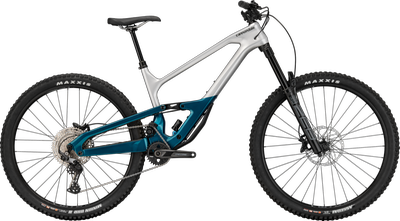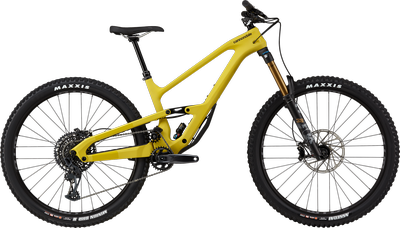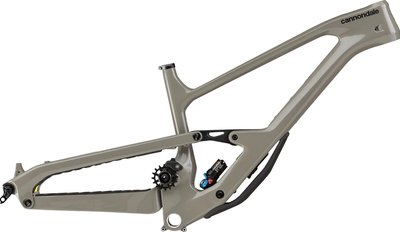Cannondale Jekyll
3 Results
Cannondale Jekyll: Your Ultimate Guide to This Enduro Beast
When it comes to crushing trails and dominating enduro races, the Cannondale Jekyll has built a reputation as a bike that’s ready to handle whatever you throw at it. Whether you’re eyeing the latest Cannondale Jekyll 1 or the slightly more accessible Cannondale Jekyll 2, this guide will walk you through everything you need to know about this legendary mountain bike.
What Makes the Cannondale Jekyll Special?
The Cannondale Jekyll isn’t just another mountain bike—it’s engineered for riders who demand performance on the gnarliest trails. One of the standout features is its high-pivot suspension system, which provides exceptional traction and control. Whether you're dropping into steep descents or navigating technical climbs, the Jekyll’s suspension design ensures a smooth, controlled ride.
Another hallmark of the Jekyll is its carbon frame, which combines strength and lightness for a perfect balance. Cannondale’s meticulous engineering allows you to push the limits without worrying about durability. If you’ve ever ridden a Jekyll, you know it’s built for riders who want to take their trail game to the next level.
The Difference Between Cannondale Jekyll 1 and Cannondale Jekyll 2
Both the Jekyll 1 and Jekyll 2 are part of the same family, but they cater to slightly different needs and budgets. Let’s break it down:
Cannondale Jekyll 1: The premium option, packed with top-tier components. It features a full-carbon frame, high-end suspension, and a drivetrain that’s built for serious riders.
Cannondale Jekyll 2: A more affordable version that still delivers exceptional performance. While it uses a mix of carbon and alloy materials, it doesn’t skimp on quality where it counts.
Both models are designed to excel in enduro racing and aggressive trail riding, so you can’t go wrong with either choice.
Who Should Ride the Cannondale Jekyll?
The Cannondale Jekyll is perfect for riders who love pushing their limits on challenging terrain. If you’re the type who craves adrenaline-fueled descents, rocky trails, and technical climbs, this bike has your name on it. Its progressive geometry and advanced suspension design make it an ideal choice for:
Enduro racers
Advanced trail riders
Mountain bikers looking to upgrade to a high-performance bike
That said, if you’re a beginner, the Jekyll might feel like overkill. But hey, if you’re up for the challenge, there’s no better bike to grow into.
Key Features of the Cannondale Jekyll
1. High-Pivot Suspension
The Jekyll’s high-pivot suspension is a game-changer. It separates the suspension’s movement from your pedaling, meaning you get unmatched efficiency and traction. Whether you’re hitting tight switchbacks or bombing down a rocky descent, the suspension keeps you stable and in control.
2. Flip Chip Technology
This feature allows you to adjust the bike’s geometry to match your riding style or the trail’s demands. Want a slacker head angle for more stability? Flip the chip. Need quicker handling for tight trails? Flip it back.
3. Robust Components
From the wide handlebars to the powerful brakes, the Jekyll is equipped with components that can handle the abuse of aggressive riding. The Cannondale Jekyll 1 comes with higher-end components like SRAM X01 Eagle, while the Cannondale Jekyll 2 offers a slightly more budget-friendly build.
4. Modern Geometry
The Jekyll’s progressive geometry is all about performance. With a slack head tube angle and a steep seat tube angle, you get a bike that’s stable at high speeds but nimble enough for technical sections.
Why the Cannondale Jekyll Stands Out
In a sea of enduro bikes, the Cannondale Jekyll distinguishes itself with its innovative design and attention to detail. The high-pivot suspension system isn’t just a gimmick; it genuinely improves your ride. Plus, the option to choose between the Jekyll 1 and Jekyll 2 means there’s a model for different budgets without sacrificing quality.
Another standout feature is the bike’s versatility. While it’s primarily designed for enduro, the Jekyll can handle everything from bike park laps to epic all-day rides. If you’re looking for a do-it-all mountain bike, this is a strong contender.
Choosing the Right Size
Getting the right size is crucial for maximizing your performance and comfort. Cannondale offers the Jekyll in multiple sizes, so you can find the perfect fit. Here’s a quick sizing guide:
Small (S): Riders 5’5” to 5’7”
Medium (M): Riders 5’7” to 5’11”
Large (L): Riders 5’11” to 6’3”
Extra Large (XL): Riders 6’3” and taller
Remember, a proper bike fit isn’t just about height - it’s also about your riding style and preferences. If you’re unsure, head to your local bike shop for a professional fitting.
Maintenance Tips for Your Cannondale Jekyll
To keep your Cannondale Jekyll running smoothly, regular maintenance is key. Here are some tips:
Clean your bike regularly: Mud and grime can wear down your components, so give your bike a good wash after every ride.
Check the suspension: Keep an eye on your shock’s air pressure and make sure the seals are clean and lubricated.
Inspect your drivetrain: Clean and lube your chain regularly, and replace worn-out parts as needed.
Tighten bolts: Check all bolts and fasteners to ensure nothing has come loose after a rough ride.
FAQ: Everything You Need to Know About the Cannondale Jekyll
1. Is the Cannondale Jekyll a good bike for beginners?
While the Jekyll is designed for advanced riders, beginners can still enjoy it if they’re willing to tackle the learning curve. However, it might be overkill for mellow trails.
2. What’s the difference between the Cannondale Jekyll 1 and 2?
The Jekyll 1 has premium components and a full-carbon frame, while the Jekyll 2 is more budget-friendly with a mix of carbon and alloy materials. Both are excellent choices for enduro riding.
3. How much does the Cannondale Jekyll weigh?
The weight varies depending on the model and size, but the Jekyll typically weighs between 32 and 34 pounds.
4. Can I use the Cannondale Jekyll for bike park riding?
Absolutely! The Jekyll’s robust design and high-pivot suspension make it a great choice for bike park laps and downhill runs.
5. How often should I service the suspension?
It’s a good idea to service the suspension every 50-100 hours of riding, depending on how aggressively you ride.
The Cannondale Jekyll is more than just a mountain bike - it’s a trail-blazing machine built for riders who crave adventure and performance. Whether you’re eyeing the Cannondale Jekyll 1 or the Cannondale Jekyll 2, you’re investing in a bike that’s ready to tackle the toughest trails and elevate your riding experience. So, what are you waiting for? Get out there and conquer the mountain!




